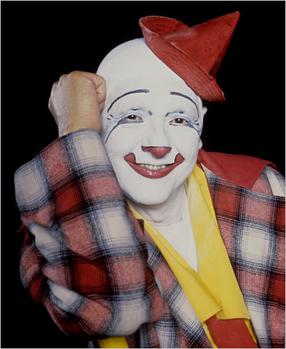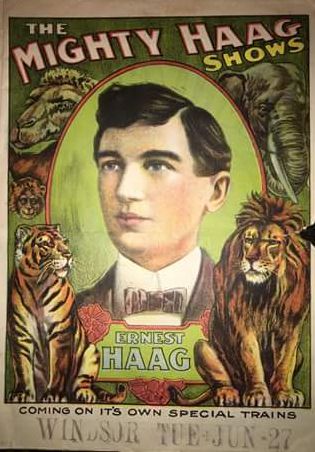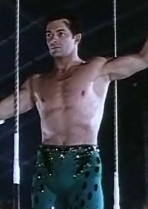
Emmett Leo Kelly was an American circus performer, who created the clown character "Weary Willie", based on the hobos of the Great Depression in the 1930s.

The Ringling Bros. and Barnum & Bailey Circus, also known as the Ringling Bros. Circus, Ringling Bros., the Barnum & Bailey Circus, Barnum & Bailey, or simply Ringling, is an American traveling circus company billed as The Greatest Show on Earth. It and its predecessor have run shows from 1871, with a hiatus from 2017 to 2023. They operate as Ringling Bros. and Barnum & Bailey. The circus started in 1919 when the Barnum & Bailey's Greatest Show on Earth, a circus created by P. T. Barnum and James Anthony Bailey, was merged with the Ringling Bros. World's Greatest Shows. The Ringling brothers purchased Barnum & Bailey Ltd. in 1907 following Bailey's death in 1906, but ran the circuses separately until they were merged in 1919.

Ringling Bros. World's Greatest Shows is a circus founded in Baraboo, Wisconsin, United States in 1884 by five of the seven Ringling brothers: Albert, August, Otto, Alfred T., Charles, John, and Henry. The Ringling brothers were sons of a German immigrant, August Frederick Rüngeling, who changed his name to Ringling once he settled in America. Four brothers were born in McGregor, Iowa: Alf T., Charles, John and Henry. The Ringling family lived in McGregor, Iowa, for twelve years, from 1860 until 1872. The family then lived in Prairie du Chien, Wisconsin, and moved to Baraboo, Wisconsin, in 1875. In 1907 Ringling Bros. acquired the Barnum & Bailey Circus, merging them in 1919 to become Ringling Bros. and Barnum & Bailey Circus, promoted as The Greatest Show on Earth. Ringling Bros. and Barnum & Bailey closed on May 21, 2017, following weakening attendance and high operating costs.
Ringling Bros. and Barnum & Bailey Clown College was an American circus school which trained around 1,400 clowns in the "Ringling style" from its founding in 1968 until its closure in 1997.

A circus train is a method of conveyance for circus troupes. One of the larger users of circus trains was the Ringling Bros. and Barnum & Bailey Circus (RBBX), a famous American circus formed when the Ringling Brothers Circus purchased the Barnum and Bailey Circus in 1907.
Irvin Feld was a business entrepreneur who built a chain of record stores, promoted rock groups, produced concerts involving some of the biggest names in popular music. Feld was the person responsible for creating the ill-fated 1959 Winter Dance Party Tour throughout the American Midwest that included Buddy Holly, Ritchie Valens, and J.P. Richardson, aka The Big Bopper. The tour route was poorly planned, zig-zagging across the Midwest in arctic weather in an old school bus that kept breaking down, eventually prompting Buddy Holly to privately hire a small plane to transport him to his next gig. Feld was also the head of Ringling Bros. and Barnum & Bailey Circus and founder of Feld Entertainment. He was a music promoter who is credited with discovering Paul Anka.
Steve Smith, professional clown and circus director, is best known to audiences as the clown character, "TJ Tatters."

The Hagenbeck–Wallace Circus was a circus that traveled across America in the early part of the 20th century. At its peak, it was the second-largest circus in America next to Ringling Brothers and Barnum and Bailey Circus. It was based in Peru, Indiana.

John Nicholas Ringling was an American entrepreneur who is the best known of the seven Ringling brothers, five of whom merged the Barnum & Bailey Circus with their own Ringling Bros. World's Greatest Shows to create a virtual monopoly of traveling circuses and helped shape the modern circus. In addition to owning and managing many of the largest circuses in the United States, he was also a rancher, a real estate developer and art collector. He was inducted into the Florida Artists Hall of Fame in 1987.

Johann Ludwig Jacob, professionally known as Lou Jacobs, was a German-born American auguste clown who performed for Ringling Bros. and Barnum & Bailey Circus for more than 60 years. He was inducted into the International Clown Hall of Fame in 1989. He is credited with popularizing the clown car, which has been a staple of circus clown acts ever since. He is also often cited as the originator of the red rubber ball nose, which is used by many clowns today. He was the first living person to have his portrait appear on an American postage stamp.
The Greatest Show on Earth may refer to:

James Andrew Haley was an American World War I veteran who served 12 terms as a U.S. Representative from Florida from 1953 to 1977.

The Ringling brothers were five American siblings who transformed their small touring company of performers into one of the largest circuses in the United States during the late 19th and early 20th centuries. Four brothers were born in McGregor, Iowa: Alfred T., Charles, John and Henry William, and the family lived in McGregor for twelve years, from 1860 until 1872. The Ringling family then moved to Prairie du Chien, Wisconsin, and finally settled in Baraboo, Wisconsin, in 1875. They were of German and French descent, the children of harness maker Heinrich Friedrich August Ringling (1826–1898) of Hanover, and Marie Salome Juliar (1833–1907) of Ostheim, in Alsace. While there were seven Ringling brothers, Alfred, Charles, John, Al and Otto Ringling were the main brothers in charge of the circus shows. All of the brothers were Freemasons. In 1919, they merged their Ringling Brothers Circus with America's other leading circus troupe, Barnum and Bailey, ultimately creating the Ringling Bros. and Barnum & Bailey Circus, which has operated continuously since except for a hiatus from 2017 to 2022.

Bello Nock, often known simply as Bello, is an American daredevil and circus performer. Nock has been listed in the Guinness Book of World Records for his highwire walk over a cruise ship. He has performed several stunts in New York City, including rappelling off of Madison Square Garden and hanging from a helicopter over the Statue of Liberty. He has been included in a Time magazine list of "America's Best Artists and Entertainers".

Feld Entertainment Inc. is an American live show production company which owns a number of traveling shows. The company began with Ringling Bros. and Barnum & Bailey Circus then expanded into additional live events, including Disney on Ice, Monster Jam, Monster Energy AMA Supercross, and Sesame Street Live. The company is family owned.

Glen Gordon "Frosty" Little was a circus clown who served with the Ringling Bros. and Barnum & Bailey Circus for over 20 years. He was one of only four clowns ever to have been given the title "Master Clown" by the Ringling organization.

Apolonia "Miss Loni" Van Voorden was a Dutch American foot juggler who began her career at the age of 10 in her father's family circus in the Netherlands.

Mighty Haag Circus was started by American entrepreneur Ernest Haag in Shreveport, Louisiana. His circus toured continuously for over 40 years, from 1891 to 1938. During these years, the circus used a variety of types of transport: boat, carts, trains, horse-pulled wagons, and trucks. It was one of the largest traveling circuses in the United States.
The Great Sebastian or Great Sebastian may refer to:

Norma Fox, also known as La Norma, is a Danish-born aerialist and trapeze artist who performed throughout Europe before moving to the United States with her husband, the Frenchman André W. Fox, in 1949. In 1952, she performed as a stand-in for Betty Hutton in the film The Greatest Show on Earth. La Norma retired in 1974 and now lives in Sarasota, Florida, where a "Ring of Fame" marker records her circus achievements.





















